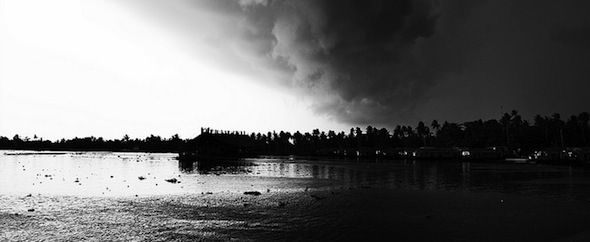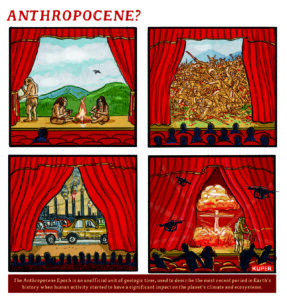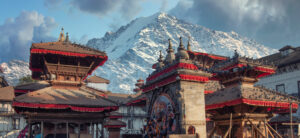Climate Change ‘Helped to End Monsoon 4,000 Years Ago’
This generation has lessons to learn from the way climate change helped topple civilizations thousands of years ago, British scientists say.
By Tim Radford, Climate News NetworkThis piece first appeared at Climate News Network.
LONDON — Climate change can seriously damage a civilisation. An “abrupt weakening” of the summer monsoon in north-west India accompanied the decline of the great cities of the Indus valley more than 4,000 years ago, according to new research by British scientists.
They analysed the oxygen isotopes in snail shells preserved in ancient lake sediments to build up a picture of rainfall patterns in prehistory, and found the first direct evidence that sustained drought contributed to the collapse of a great Bronze Age civilisation, they report in the journal Geology.
The Indus or Harappan civilisation – after Harappa, one of the five great ancient settlements of what is now Pakistan and western India – was marked by the world’s first “megacities”, concentrations of population in built-up areas that covered more than 80 hectares.
“They engaged in elaborate crafts, extensive local trade and long-ranging trade with regions as far away as the modern-day Middle East,” said Cameron Petrie of the University of Cambridge. “But by the mid-second millennium BC, all the great urban centres had dramatically reduced in size or been abandoned.”
The finding links the decline of the Indus civilisation to what now seems a much greater scale event: the failure of Early Bronze Age civilisation in Greece and Crete, the weakening of the Old Kingdom in Egypt, and the crumbling of the Akkadian Empire in Mesopotamia.
Common factor
Researchers last year used pollen grain sediments in an old lake bed in Cyprus to build up a picture of sustained environmental decline that accompanied the collapse of the civilisations linked with Mycenae in Greece and Knossos in Crete. In all cases, there must have been a number of factors at work, but common to them all was a pattern of drought.
Without water crops fail, populations fall and concentrations of people must disperse. Archaeological evidence in the north-west Indian sub-continent has told a story of dispersal. Palaeontological evidence from an old lake bed has confirmed the picture of a changing climate.
“We think we now have a really strong indication that a major climate change event occurred in the area where a large number of Indus settlements were situated,” said David Hodell, an earth scientist at Cambridge, and one of the authors.
“Taken with other evidence from Meghalaya in north-east India, Oman and the Arabian Sea, our results provide strong evidence for a widespread weakening of the Indian summer monsoon across large parts of India 4,100 years ago.”
The authors collected shells of the water snail Melanoides tuberculata from the sediments on an ancient lake, Kotla Dahar in Haryana, India. The changes in oxygen isotope ratios over a period of thousands of years told the researchers a story of a deep lake that became a shallower one, as evaporation accelerated and water supplies dwindled, and then all but disappeared, with an abrupt weakening of the monsoons that lasted around 200 years.
Syrian parallel?
Oxygen occurs in two isotopes: water molecules containing the lighter variant evaporate at a predictably faster rate than the heavier version. In a drought, the ratios of the heavier version increase, and this increase is preserved in the calcium carbonate of the snail shells, which can in turn be dated by radiocarbon measurements.
Archaeological evidence suggests that around the time of the 200-year drought, streets that had once been well-maintained started to fill with rubbish, craftsmanship seemed to become less sophisticated, and the locations of settlements changed.
“It is essential to understand the link between human settlement, water resources and landscape in antiquity,” said Dr Petrie. “We hope that this will hold lessons for us as we seek to find means of dealing with climate change in our own and future generations.”
Simultaneously, a French academic has argued that extended drought may have played a role in the crisis in Syria right now. Francesca de Chatel of Radboud University in the Netherlands writes in Middle Eastern Studies that in her opinion the bloodshed and turmoil in Syria is the culmination of 50 years of sustained mismanagement of water and land resources, capped by a severe drought during the years 2006-2010.
She argues “It was not the drought per se, but rather the government’s failure to respond to the ensuing humanitarian crisis that formed one of the triggers of the uprising, feeding a discontent that had long been simmering in rural areas.”
Your support matters…Independent journalism is under threat and overshadowed by heavily funded mainstream media.
You can help level the playing field. Become a member.
Your tax-deductible contribution keeps us digging beneath the headlines to give you thought-provoking, investigative reporting and analysis that unearths what's really happening- without compromise.
Give today to support our courageous, independent journalists.






You need to be a supporter to comment.
There are currently no responses to this article.
Be the first to respond.